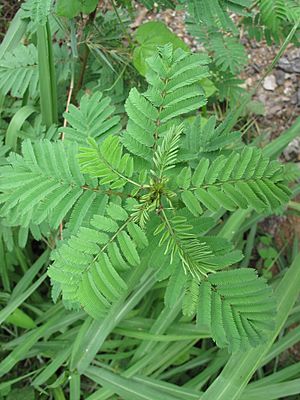Desmanthus bicornutus facts for kids
Quick facts for kids Desmanthus bicornutus |
|
|---|---|
 |
|
| Conservation status | |
| Scientific classification | |
| Kingdom: | |
| (unranked): | |
| (unranked): | |
| (unranked): | |
| Order: | |
| Family: | |
| Subfamily: | |
| (unranked): | |
| Genus: |
Desmanthus
|
| Species: |
D. bicornutus
|
| Binomial name | |
| Desmanthus bicornutus S.Watson
|
|
Desmanthus bicornutus is a type of flowering plant. It belongs to the legume family, which includes plants like peas and beans. This plant grows naturally in northern and central Mexico and the southwestern United States. You might often see it growing along roadsides in these areas. It's also known by common names like ruby bundleflower and two-horn bundleflower. In Mexican Spanish, it's called malvilla de laguna.
Contents
What is Desmanthus bicornutus Like?
This plant is a small, upright shrub. It can grow up to about 3 meters (nearly 10 feet) tall. It has a strong, woody base.
Stems and Leaves
When the stems are young, they are often a deep red color. As they get older, they turn a shiny red or brown. The leaves are made up of many smaller leaflets, like a fern. These leaves can be between 9 and 18 centimeters (about 3.5 to 7 inches) long.
Flowers and Pods
Desmanthus bicornutus produces many small flowers. These flowers grow in tight clusters called spikes. Each spike can have 25 to 60 flowers. Some flowers have both male and female parts, while others are only male or cannot produce seeds.
After flowering, the plant grows long, thin pods. There can be up to twelve pods on each fruiting stalk. These stalks can be up to 5 centimeters (about 2 inches) long. The pods themselves can be up to 10 centimeters (about 4 inches) long and 5.5 millimeters (about 0.2 inches) wide. When they are young, the pods are red. But as they ripen, they turn a dark brown color.
Where Does Desmanthus bicornutus Grow?
This plant is found in several states in northern and central Mexico. These include Baja California Sur, Chihuahua, Sinaloa, Sonora, Colima, Guerrero, Jalisco, Michoacán, Nayarit, and Veracruz. In the United States, D. bicornutus grows naturally only in the state of Arizona.
How Does It Live in Nature?
Desmanthus bicornutus prefers certain types of soils. It likes clay, rocky, or sandy soils where it grows naturally.
Different Environments
At higher elevations, you can find D. bicornutus growing among oak forests and in grasslands. At lower elevations, this plant is often found near canyons, roads, and along waterways.
Surviving Dry Times
This plant can grow in areas with very different amounts of rainfall. Some places get only 300 millimeters (about 12 inches) of rain a year, while others get up to 2,000 millimeters (about 79 inches). However, D. bicornutus is usually found in places that have long, intense dry seasons. These dry periods can last for up to ten months!
During winter or the dry season, the plant often dies back to its base. But when conditions improve, it grows new leaves and stems. It can also regrow after wildfires.
How Do People Use Desmanthus bicornutus?
This plant has a few interesting uses.
Food and Farming
In Guerrero, Mexico, the beans from D. bicornutus are used to make salsa.
In northern Mexico and southern Arizona, this plant is part of the natural grasslands. It is good for grazing livestock (farm animals like cows). The plant can handle being heavily grazed, which means animals can eat a lot of its leaves without harming it too much.
Research and Cultivation
D. bicornutus has been grown in experimental plots in Australia. Even though it grows easily as a weed in its native areas, it has not spread out of control in these test plots. This suggests it might not become an invasive species there. Scientists at Texas A&M University have even developed a few special types, or cultivars, of D. bicornutus.



